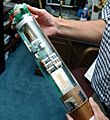Telemetry facts for kids
Telemetry is a cool technology that lets us measure things and control stuff from far away. Imagine you're playing a video game, but instead of controlling a character, you're controlling a real robot or a weather balloon miles away!
Telemetry works by sending information back and forth. A machine far away can take measurements, like temperature or speed. Then, it sends this data to you, often using wireless communication or even a phone line. You can also send commands back to the machine, telling it what to do next. It's like having a conversation with a machine over a long distance!
Contents
What is Telemetry?
Telemetry is a mix of two Greek words: "tele" meaning "remote" or "far away," and "metron" meaning "measure." So, it literally means "remote measuring."
It's not just about measuring, though. It also includes sending commands. This two-way communication is what makes telemetry so powerful. It helps us understand and control things we can't easily reach.
How Does Telemetry Work?
Telemetry systems have a few key parts:
- Sensors: These are like the machine's "eyes" and "ears." They collect data, such as temperature, pressure, speed, or location.
- Transmitter: This part takes the data from the sensors and turns it into a signal that can be sent over long distances.
- Communication Link: This is the path the signal travels. It could be radio waves, satellite communication, fiber optic cable, or even a simple telephone line.
- Receiver: This part catches the signal and turns it back into useful data.
- Display/Recorder: This shows the data to people or saves it for later analysis.
- Controller (optional): Sometimes, there's also a part that lets people send commands back to the remote machine.
Imagine a weather balloon. It has sensors to measure temperature and humidity high in the sky. A transmitter sends this data down to a receiver on the ground. Scientists can then see this information and understand the weather better.
Where is Telemetry Used?
Telemetry is used in many exciting areas. It helps us explore, stay safe, and even have fun!
Space Exploration
Telemetry is super important for space missions. When a spacecraft like a Mars rover is millions of miles away, scientists on Earth use telemetry to:
- Receive pictures and data about the planets.
- Monitor the spacecraft's health, like its battery level or temperature.
- Send commands to the rover, telling it where to drive or what rocks to study.
Without telemetry, we wouldn't know what's happening in space!
Weather Forecasting
Weather balloons, like the one shown below, use telemetry. They carry sensors high into the atmosphere to collect data on:
- Air pressure
- Temperature
- Humidity
- Wind speed and direction
This information is sent back to weather stations. It helps meteorologists create more accurate weather forecasts, which are important for everyone.
Sports and Racing
In Formula 1 racing, telemetry is used to monitor race cars in real-time. Engineers in the pit lane can see:
- Engine performance
- Tire temperature
- Fuel levels
- Driver's heart rate
This data helps them make quick decisions during a race, like when to change tires or how to adjust the car's settings. It's also used in other sports to track athlete performance.
Healthcare
Telemetry is also used in hospitals. Patients might wear small devices that monitor their heart rate or other vital signs. This data is sent wirelessly to a central station, allowing nurses and doctors to keep an eye on many patients at once, even if they are not right next to them. This is especially helpful for patients who need constant monitoring.
Environmental Monitoring
Scientists use telemetry to study the environment. For example, they might attach small transmitters to wildlife, like birds or turtles. This allows them to track the animals' movements, understand their migration patterns, and learn about their habitats without disturbing them. Telemetry can also monitor air and water quality in remote areas.
Smart Homes and Cities
In smart homes, telemetry can connect devices like thermostats, lights, and security cameras. You can control them from your phone, even when you're not home. Smart cities use telemetry to manage traffic lights, monitor public utilities, and even detect pollution, making cities more efficient and safer.
The Future of Telemetry
Telemetry is always improving. With new technologies like 5G and better sensors, it will become even faster and more reliable. We might see more self-driving cars that use telemetry to communicate with each other and with traffic systems. Robots could become even more common, controlled remotely for dangerous jobs or exploring new places. Telemetry will continue to help us connect with and understand the world around us, no matter how far away things are.
Images for kids
-
An expendable dropsonde used to capture weather data. The telemetry consists of sensors for pressure, temperature, and humidity and a wireless transmitter to return the captured data to an aircraft.
See also
 In Spanish: Telemetría para niños
In Spanish: Telemetría para niños


